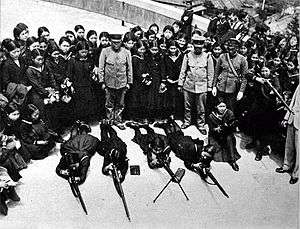Volunteer Fighting Corps

Volunteer Fighting Corps (国民義勇戦闘隊 Kokumin Giyū Sentōtai) were armed civil defense units planned in 1945 in the Empire of Japan as a last desperate measure to defend the Japanese home islands against the projected Allied invasion during Operation Downfall (Ketsugo Sakusen) in the final stages of World War II.
They were the Japanese equivalent of the German Volkssturm.[1] Its Commander-in-Chief was former Prime Minister General Koiso Kuniaki.[2]
History
Volunteer Corps
In March 1945, the cabinet of Japanese Prime Minister Kuniaki Koiso passed a law establishing the creation of unarmed civil defense units, Volunteer Corps (国民義勇隊 Kokumin Giyūtai). With the assistance of the Taisei Yokusankai political party, the tonarigumi and Great Japan Youth Party, units were created by June 1945.
The Kokumin Giyūtai was not combatant, but working unit for fire service, food production, and evacuation. All male civilians between the ages of 12 to 65 years, and females of 12 to 45 years were members. They received training on fire fighting techniques and elementary first aid.
Reformation as militia
In April 1945, the Japanese cabinet resolved on reforming Kokumin Giyūtai into civilian militia. In June, the cabinet passed a special conscription law, and named the militia units Volunteer Fighting Corps (国民義勇戦闘隊 Kokumin Giyū Sentōtai).
The Kokumin Giyū Sentōtai would be organized, if the Allied landing unit close to the Japanese homeland. Governors of Prefectures could conscript all male civilians between the ages of 15 to 60 years, and unmarried females of 17 to 40 years.[1] Commanders were appointed from retired military personnel and civilians with weapons experience.
Combat training sessions were held, although the corps was primarily assigned to support tasks, such as construction, transportation and rationing.
The Volunteer Fighting Corps was intended as main reserve along with a "second defense line" for Japanese forces to sustain a war of attrition against invading forces. After the Allied invasion, these forces were intended to form resistance or guerilla warfare cells in cities, towns, or mountains.
Strength
Some 28,000,000 men and women were considered "combat capable" by the end of June 1945, yet only about 2,000,000 of them were recruited when the war ended, and most of them did not experience combat due to Japan's surrender before the Allied invasion of the Japanese home islands. The Battle of Okinawa took place before the formation of Volunteer Fighting Corps.[3] At this stage of the war, the lack of modern weaponry and ammunition meant that most were armed with swords or even bamboo spears.
Within Japan proper, the Volunteer Fighting Corps were never used in combat, except in South Sakhalin (the Battle of Okinawa occurred before its formal inception, with local Boeitai home guard conscripts forming part of the defences there). And the similar units organized in Japanese exterior provinces were used in battle. The units in Korea, Kwangtung, and Manchukuo sustained heavy casualties in combat against the Soviet Union during the Soviet invasion of Manchuria during the last days of World War II.[4]
The Kokumin Giyūtai was abolished by order of the American occupation forces after the surrender of Japan.
Equipment
The Kokumin Giyu Sentōtai units were theoretically armed with weapons including:
- Type 94 8 mm Pistol
- Type 30 rifle
- Type 38 rifle
- Type 44 Cavalry Rifle
- Type 1 Heavy Machine Gun
- Type 5 Anti-aircraft gun
- Type 4 20 cm Rocket Launcher
- Type 10 Grenade Discharger
- Type 89 Grenade Discharger
- Ceramic hand grenades
- "Lunge AT Mine" (anti-tank mine on bamboo pole)
In actuality, mostly only much less sophisticated arms were available:
- "Molotov Cocktails"
- Simple pointed bamboo or wood sticks[1]
- Swords, bayonets, knives and even pole weapons & staff weapons (e.g. Guntō, Type 30 bayonet, Hori hori, Kamayari/Naginata & Hanbō/Jō)
- Clubs and truncheons such as the Kanabō or even simpler
- Antiquated firearms (e.g. Murata rifle)
However, Type 4 grenades were in plentiful enough supply due to their ease of manufacture.
See also
- Boeitai
- Himeyuri students
- Tekketsu Kinnotai
- Matsushiro Underground Imperial Headquarters
- Kamikaze
- Japanese holdout
- Stay-behind
- Senjinkun military code
Other nations:
References
- Drea, Edward J. (1998). "Japanese Preparations for the Defense of the Homeland & Intelligence Forecasting for the Invasion of Japan". In the Service of the Emperor: Essays on the Imperial Japanese Army. University of Nebraska Press. ISBN 0-8032-1708-0.
- Frank, Richard B (1999). Downfall: The End of the Imperial Japanese Empire. New York: Random House. ISBN 0-679-41424-X.
- Skates, John Ray (1994). The Invasion of Japan: Alternative to the Bomb Downfall. New York: University of South Carolina Press. ISBN 0-87249-972-3.
Notes
- 1 2 3 Hasegawa, Tsuyoshi (2007). The end of the Pacific war: Reappraisals. Stanford University Press. pp. 75–77. ISBN 0-8047-5427-6.
- ↑ Shillony, Ben-Ami (1981). Politics and Culture in Wartime Japan. Oxford University Press. pp. 82–83. ISBN 0-19-820260-1.
- ↑ Japanese wikipedia
- ↑ Frank, Downfall, the End of the Japanese Empire